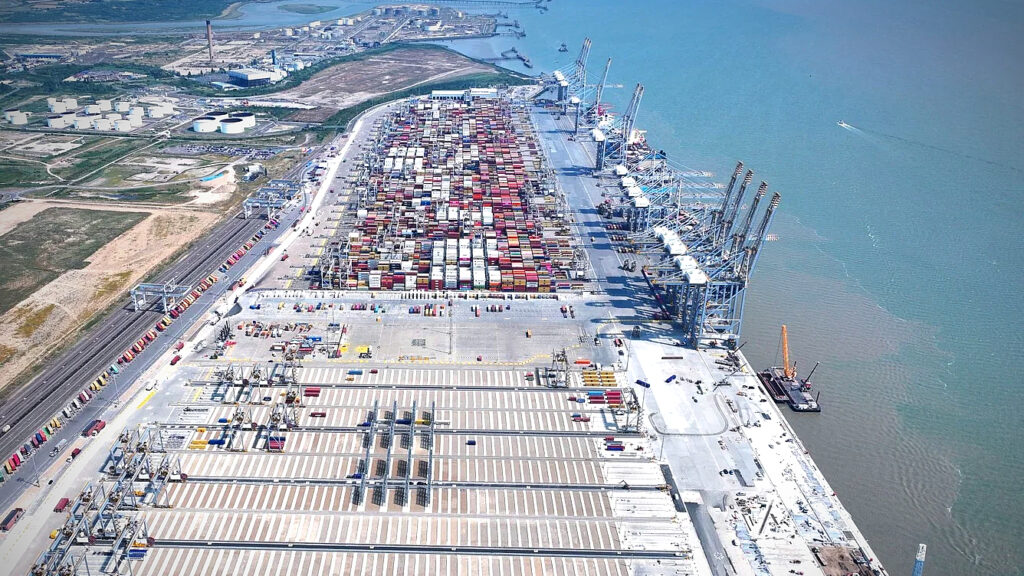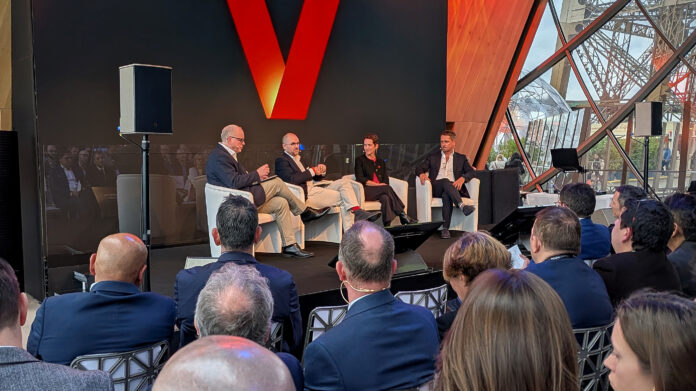Verizon Business and Nokia showcased their special relationship at the US firm’s first European ‘innovation session’ yesterday – at the Eiffel Tower in Paris. They were joined by Axa, Michelin, and Prada to discuss critical connectivity in the new AI era, and put the spotlight on their “special” private 5G project at Thames Freeport in the UK.
In sum – what to know:
European partners – Verizon Business hosts its first non-US innovation session in Paris, bringing together major partners and customers as part of collaborative ecosystem approach.
Critical connectivity – Private 5G and SD-WAN take centre stage; Axa, Michelin, and Prada say connectivity is now a boardroom-level concern for global data-driven enterprises.
Tech regeneration – Thames Freeport project with Nokia in London is looking like the ultimate private 5G how-to, incorporating industrial efficiency and community upskilling.
“This one’s a bit special, isn’t it?”, says Verizon Business to Nokia. “We do a lot with Nokia but this one’s special.” We are a level up in a reception room in the Eiffel Tower, with grand views of Paris looking out the windows on one side, and bemused tourists looking in the other, making their way up the city’s most iconic monument – which, we’ve just been told, was designed as a temporary structure, and originally booed by the chattering classes. Maybe AI will be the most enduring construction of the digital age – is the message. “Yeah, this one is really special,” responds Nokia.
They are represented on either side of a four-person panel by Tony Judd and Michael Aspinall – managing director in the UK and Ireland and head of campus-edge sales in Europe for the two firms, respectively. This whole event – October 15, Paris: the US firm’s first non-US ‘innovation session’ for tech partners and business customers – feels like a love-in, most notably with Nokia, which has a good demo in the back, and has just featured as one half of an opening double-act with its host. But the bonhomie (likely the same with Ericsson at some US sessions) goes further.
We hear from insurance firm Axa, tyre manufacturer Michelin, and fashion house Prada. None, RCR understands, are taking private 5G from Verizon Business (yet), but all are taking network services of other kinds (mostly SD-WAN software, maybe some IoT solutions) – and all of them have the same message: that critical-grade connectivity is, suddenly, a key boardroom concern in global enterprises. “The discussion has completely changed,” says Prada. “Three years ago, the network was only talked about in the boardroom when it wasn’t working.”
Same, says Michelin, adding: “As a data-driven company, the transfer of data has become key.” Same, says Axa: “The network is the very [foundation] of our services.” Daniel Lawon, senior vice president for global solutions at Verizon Business, and host of the Axa/Michelin/Prada panel, comments: “All these AI data centers [will] be very expensive paper weights if they don’t connect to anything.” You get the gist – lots of talk about the team sport of ‘solving-for’, and how it takes a village. “There’s not a single company that can do this alone.”
This last quote is from Jennifer Artley, in charge of the ‘5G acceleration’ team at Verizon Business, which is stealing prime private-5G contracts from under the noses of local operator groups in Europe. (No other US carrier is doing this.) She is sitting between Judd and Aspinall on the first panel to talk about this ‘special one’ – a port, covered in these pages already, across La Manche. There are 100 people in the audience, including lots of customers and potential customers – we are told. (Someone else is keeping count in the Notes app on their phone, and the list looks decent.)
The Industry 4.0 ecosystem is properly embedded on Nokia’s demo at the back: Bosch (sensor module), Bosch Rexrouth (protocol translation), Ipsotek (video analytics), Crosser, (streaming analytics), Litmus Edge (data integrity), plus others. The best comment is from Massimo Peselli, chief revenue (corporate sales) officer at Verizon Business, during a group media interview. “I don’t care,” he says, almost exasperated – in response to a question about whether his company wants, necessarily, to lead this Industry 4.0 dance, and ‘own’ the customer relationship.
“I really don’t care. Customers make a choice. I just want to bring our bit to the table – and do it well. The customer can choose the commercial model.” RCR will write more from some of these presentations and conversations. The point of this piece is to (re)present arguably the most interesting private 5G project anywhere – this “special” case we keep referencing, which its suppliers are so chuffed about: Thames Freeport in London, a designated UK ‘economic zone’ on the north bank of the river, where six private networks are being installed at four logistics hubs.
The story is covered here; but half way up the Eiffel Tower, between Judd and Aspinall (and Artley), sits Tom White, director of innovation at Thames Freeport. “Yeah, this one is special,” says Aspinall, saying something about “ticking all the boxes” and “generational change” at Thames Freeport, and handing back to Judd – who asks a question and hands to White. “We are probably London’s biggest project that you’ve never heard of,” responds White. And here is the rest of what he says, with no more interruption from us. (Following the intro, below the image, Judd’s questions are also included.)

“Thames Freeport… [is a] special economic zone in an area of East London where London’s growth is constrained to the northwest and the south, and the only direction it can grow is our way. We’re a baked-in public-private partnership between the newest port in the UK, DP World London Gateway, quickly becoming one of the UK’s largest ports, the Port of Tilbury, which is 200 years old and has evolved like so many ports around the world, and the Ford Motor Company at Dagenham, which was Henry Ford’s first factory outside of the US, or certainly his first in the UK.
“We were set up by the last government to drive regeneration in the region – to bring 20,000 new jobs to the community and deliver £6.5 billion of inward investment over 30 years. We could have very easily gone about that mission by trying to fill our sites with low-value jobs – lots of call centres, and warehouses… But we saw a bigger opportunity, which is [to establish] a platform to reinvent the [local] economy, bring future manufacturers to the UK, build more sustainable high-quality homes, and drive more efficient and resilient logistics in the region…
“We are set up as a value-generating engine for the region delivering… new commercial value for the businesses that are already here, and the seeds [of new value] for businesses that we want to move here. And we are trying to… [drive] equitable growth so that we’re not just supporting [local businesses], but to actually [support] the community of about a million people with… better healthcare systems, better public services, better access to good jobs and skills.”
And one of the first decisions you made was the ubiquitous deployment of private 5G. Why?
“It goes back to the targets we set. We were looking to bring high-tech modern industries to our region to provide high-productivity jobs. And we took that back to the things we could invest in that we knew those industries needed. It isn’t about the technology; it’s about how to generate value for a region – by helping it to move materials around more cheaply, and by having more resilient systems to deploy more AI into manufacturing processes…. [Which means] foundational connectivity on which to build [these] applications.
“What steered us towards private 5G is that UK ports are critical assets. If you want to disrupt the UK, as an island nation,, you don’t need an army, or a navy, or an air force; you just need to close down the ports… Fifty percent of the food and drink in the UK is imported via the ports; 98 percent of all the UK’s exports move through the ports…”
About inward investment and growing businesses, and how that drives employment – there is a huge skills shortage. Talk about some of the approaches you’ve taken there.
“We have skills shortages in the traditional sectors, for a start. Part of the response to a lack of skills is how to deploy technology to bridge the skills gap as well. It creates new opportunities for people in the region to work [with technology] within those industries – whether [with] remote control cranes, predictive maintenance systems. [Because[ the skills you need to be a crane driver 90 feet up a ladder are different to the skills to be a crane driver operating eight cranes on a virtual system. We are funding lots of training to upskill people already in the industry – as practitioners, using the technology, and in the leadership, about how these capabilities change industries, and how industries need to think about in future.
“A lot of times when these sorts of regeneration programmes happen, particularly in deprived areas, they are perceived as opportunities for somebody else – that these high-quality jobs will be taken by people moving into the region; that they will take those opportunities. And that is absolutely not what we are doing. We are creating opportunities for the community. So we’re out working in schools to get them interested in what technology can do for them and their community, but helping them understand that these opportunities are for them, and that these are the programmes we can offer through schools. We are supporting apprenticeships and work experience, and lots of other areas. And we are doing that together with our partners.”
Two years from now – what’s the vision?
“There are some practical things. Two years from now we will have trained at least 500 people in logistics, specifically, and many hundreds more in other areas. Our [private 5G] network[s] will be fully active. We will have been through two years of pushing solutions out into the space. So we will have a more efficient port. And in terms of objectives and outcomes, we are looking for the port to realize a 20 percent efficiency improvement in terms of how it moves things around – which [relates to] port worker productivity. So we will be on our way to achieving that.
“We will have our first applications deployed in primary care and the major regional hospital – to connect that economic growth at the port with better community services. Which will make people healthier, and workers healthier and more able to be more productive and have better health outcomes. And really fundamentally, in two years, we want to be that reference case in Europe for how to do it… – to use technology [in] complex critical systems to drive wider regional economic regeneration projects.”

